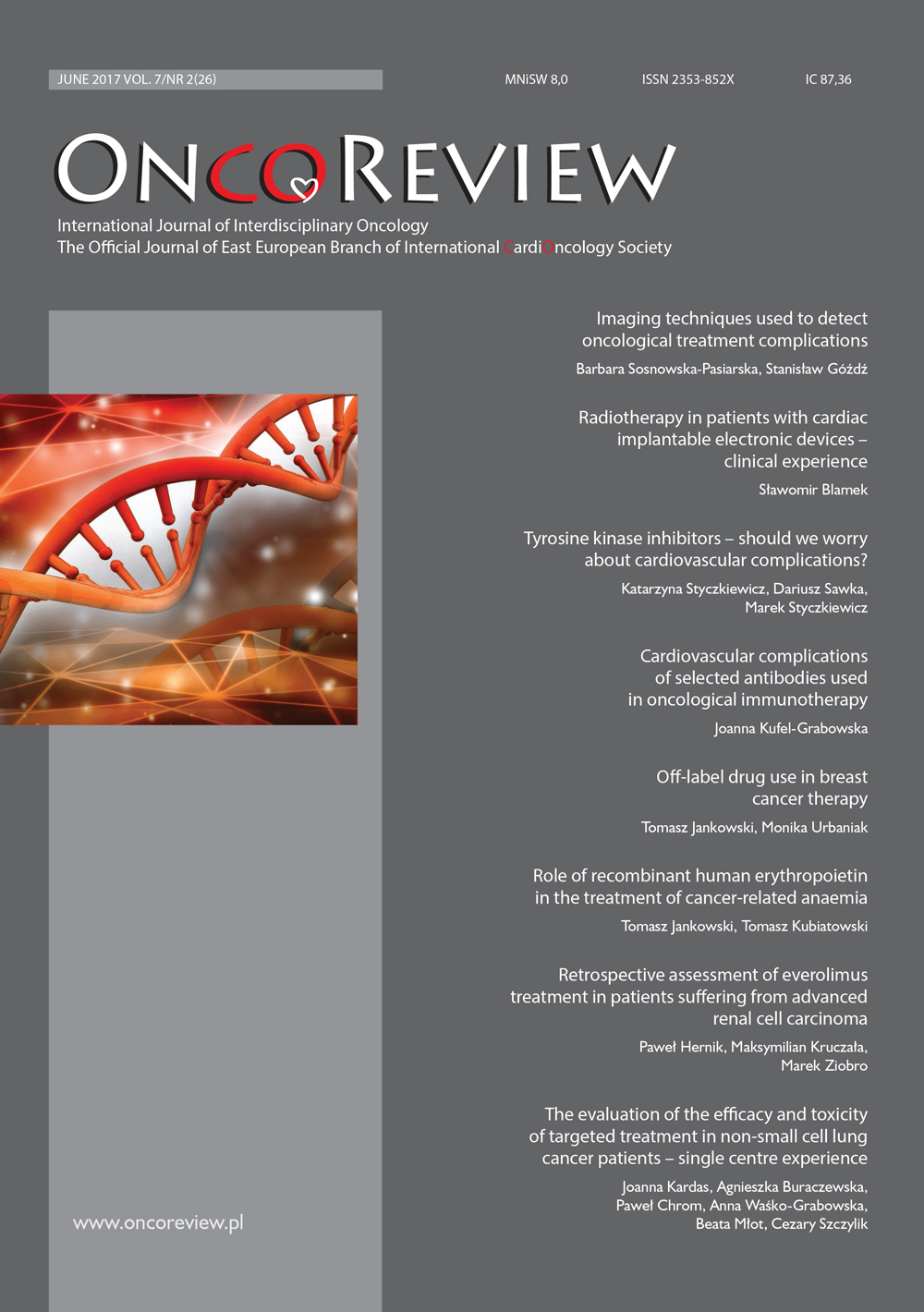Tyrosine kinase inhibitors – should we worry about cardiovascular complications? Review article
Main Article Content
Abstract
Drobnocząsteczkowe inhibitory kinaz tyrozynowych stanowią skuteczną opcję terapeutyczną dla pacjentów z nowotworami hematologicznymi i guzami litymi. Z drugiej strony, podkreśla się znaczenie sercowo-naczyniowych działań niepożądanych związanych z ich stosowaniem, takich jak: nadciśnienie tętnicze, niewydolność serca, choroba wieńcowa/ostre zespoły wieńcowe i wydłużenie odstępu QT. W niniejszej pracy omówiono mechanizmy leżące u podłoża zdarzeń sercowo-naczyniowych związanych z terapią inhibitorami kinaz tyrozynowych oraz przedstawiono możliwości ich prewencji i leczenia w praktyce klinicznej. Świadomość możliwych powikłań sercowo-naczyniowych, regularne monitorowanie, wczesna diagnoza i wdrożenie odpowiedniego leczenia w połączeniu ze ścisłą współpracą z kardiologami może zwiększyć korzyści z długoterminowej terapii tą grupą leków.
Downloads
Metrics
Article Details

This work is licensed under a Creative Commons Attribution-NonCommercial 4.0 International License.
Copyright: © Medical Education sp. z o.o. This is an Open Access article distributed under the terms of the Attribution-NonCommercial 4.0 International (CC BY-NC 4.0). License (https://creativecommons.org/licenses/by-nc/4.0/), allowing third parties to copy and redistribute the material in any medium or format and to remix, transform, and build upon the material, provided the original work is properly cited and states its license.
Address reprint requests to: Medical Education, Marcin Kuźma (marcin.kuzma@mededu.pl)
References
2. 2016 ESC Position Paper on cancer treatments and cardiovascular toxicity developed under the auspices of the ESC Committee for Practice Guidelines. The Task Force for cancer treatments and cardiovascular toxicity of the European Society of Cardiology (ESC). Eur Heart J 2016; 37: 2768-2801.
3. Izzedine H, Ederhy S, Goldwasser F et al. Management of hypertension in angiogenesis inhibitor-treated patients. Ann Oncol 2009; 20: 807-815.
4. Zhu X, Stergiopoulos K, Wu S. Risk of hypertension and renal dysfunction with an angiogenesis inhibitor sunitinib: Systematic review and meta-analysis. Acta Oncologica 2009; 48: 9-17.
5. Hamnvik OPR, Choueiri TK, Turchin A et al. Clinical risk factors for the development of hypertension in patients treated with inhibitors of the VEGF signaling pathway. Cancer 2015; 121(2): 311-319.
6. 2013 ESH/ESC Guidelines for the management of arterial hypertension. The Task Force for the management of arterial hypertension of the European Society of Hypertension (ESH) and of the European Society of Cardiology (ESC). Eur Heart J 2013; 34: 2159-2219.
7. Zasady postępowania w nadciśnieniu tętniczym – 2015 rok. Wytyczne Polskiego Towarzystwa Nadciśnienia Tętniczego. Nadciśnienie Tętnicze w Praktyce 2015; 1(1): 1-70.
8. Rini BI, Cohen DP, Lu DR et al. Hypertension as a Biomarker of Efficacy in Patients With Metastatic Renal Cell Carcinoma Treated With Sunitinib. J Natl Cancer Inst 2011; 103: 763-773.
9. Ghatalia P, Morgan CJ, Je Y et al. Congestive heart failure with vascular endothelial growth factor receptor tyrosine kinase inhibitors. Crit Rev Oncol Hematol 2015; 94(2): 228-237.
10. Hahn VS, Lenihan DJ, Ky B. Cancer therapy-induced cardiotoxicity: basic mechanisms and potential cardioprotective therapies. J Am Heart Assoc 2014; 3(2): e000665. https://doi.org/ 10.1161/JAHA.113.000665.
11. 2016 ESC Guidelines for the diagnosis and treatment of acute and chronic heart failure. The Task Force for the diagnosis and treatment of acute and chronic heart failure of the European Society of Cardiology (ESC). Eur Heart J 2016; 37: 2129-2200.
12. Hall PS, Harshman LC, Srinivas S et al. The frequency and severity of cardiovascular toxicity from targeted therapy in advanced renal cell carcinoma patients. JACC Heart Fail 2013; 1(1): 72-78.
13. Herrmann J, Yang EH, Iliescu CA et al. Vascular Toxicities of Cancer Therapies The Old and the New – An Evolving Avenue. Circulation 2016; 133:1272-1289.
14. Dahlén T, Edgren G, Lambe M et al. Cardiovascular Events Associated With Use of Tyrosine Kinase Inhibitors in Chronic Myeloid Leukemia: A Population-Based Cohort Study. Ann Intern Med 2016; 165(3): 161-166.
15. Valent P, Hadzijusufovic E, Schernthaner GH et al. Vascular safety issues in CML patients treated with BCR/ABL1 kinase inhibitors. Blood 2015; 125(6): 901-906.
16. 2013 ESC guidelines on the management of stable coronary artery disease. The Task Force on the management of stable coronary artery disease of the European Society of Cardiology. Eur Heart J 2013; 34: 2949-3003.
17. Kloth JSL, Pagani S, Verboom MC et al. Incidence and relevance of QTc-interval prolongation caused by tyrosine kinase inhibitors. Br J Cancer 2015; 112: 1011-1016.
18. Lenihan DJ, Kowey PR. Overview and Management of Cardiac Adverse Events Associated With Tyrosine Kinase Inhibitors. The Oncologist 2013; 18: 900-908.
19. 2015 ESC Guidelines for the management of patients with ventricular arrhythmias and the prevention of sudden cardiac death. The Task Force for the Management of Patients with Ventricular Arrhythmias and the Prevention of Sudden Cardiac Death of the European Society of Cardiology (ESC). Eur Heart J 2015; 36(41): 2793-2867.

